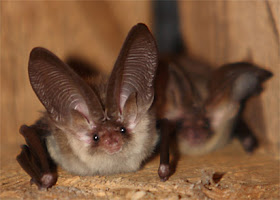Their roosting habits have been perfectly illustrated in a study that a friend Izabel Phillips did exploring the effects of temperature and humidity on bat activity. Izabel monitored how common pipistrelle Pipistrellus pipistrellus and brown long-eared bats Plecotus auritus used the barn over the course of a year. She recorded numbers of bats, their respective roosting locations and the temperature and humidity within the barn. This is summarised in an extract from her study, below.
On entering the barn a brown long-eared was picked up on the bat detector immediately. It was flying around in the more open (eastern) part of the barn, and soon settled on the brickwork at the apex of the eastern wall. A second brown long-eared was recorded in the apex of the roof at the western end, this bat was awake but still looked quite sleepy. It was settled next to a daddy long-legs spider Pholcus phalangioides and a herald moth Scoliopteryx libatrix, so there were some easy pickings for when it woke up!
 |
| Brown long-eared Bat with Daddy long-legs spider and Herald Moth |
There were of course other easy picking throughout the barn, as well as the herald moth, small tortoiseshell and peacock butterflies were present. Judging by the number of butterfly wings lying around, it appears that the bats have been taking advantage of this 'in house' food source. It is interesting how they would find these moths and butterflies as long-eared bats usually feed by gleaning their prey at close quarters within dense foliage. Their prey would normally be moving but these moths and butterflies are clearly hibernating.
 |
| Brown long-eared Bats - Hook Barn |
Brown long-eared bats are one of my favourite bat species, they are not rare, but because of their quiet echolocation they can be very easily overlooked. In the UK there are two long-eared bat species, brown, which is common and widespread and grey P. austriacus, which is extremely rare and restricted to the extreme south/south-west of the UK and the Isle of Wight. Both species have large ears which they use to listen for their prey. They tend to feed on moths, such as large yellow underwings, and there have been some interesting evolutionary battles going on between this moth species and the and the long-eareds.
 |
| A torpid brown long-eared Bat |
When torpid long-eared bats can lose body temperature through their large ears, but to combat this they tuck their ears behind their wings. The image above shows a torpid bat and the those long ears clearly tucked behind the wing membrane. The mild weather conditions have probably prevented these two bats from entering hibination yet. Whilst in the barn we also recorded single serotine and common pipistrelle, these two bats were still asleep and appeared torpid. I suspect the cold overnight temperatures may have triggered these bats to enter torpor, but the long-eareds are perhaps more tolerant of colder temperatures.

Your blog was brought to my attention by Google alert. I really enjoyed your bat post. It is clear from your posts that you apprecate and have an interest in all creatures/animals. Good Post Kirk Langley BC
ReplyDeleteWow, wonderful photos of long-eared bats! I hope to see some one day, their ears are amazing.
ReplyDelete